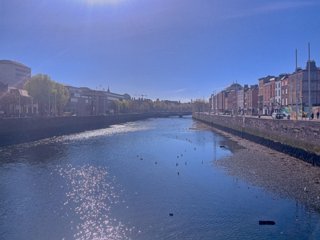ALL YOU NEED TO KNOW ABOUT THE AREA
A Walk from Capel Street to Dundrum
Today was Sunday and the weather was beautiful so after having lunch at Eatokyo on Capel Street I walked across Grattan Bridge and down Wellington Quay and got on the 74 bus and remained on board until we reached the LUAS Tram Stop in Dundrum.
Grattan Bridge
Grattan Bridge is a road bridge spanning the River Liffey in Dublin, Ireland, and joining Capel Street to Parliament Street and the south quays. The bridge was originally developed by Sir Humphrey Jervis in 1676 and was named Essex Bridge. It was rebuilt in the 1750s by George Semple and again in the 1870s, when it was renamed Grattan Bridge.
Key Features
- Seahorses: Features ornate cast iron lamp standards with mythical hippocampus sculptures.
- Lamp Standards: Wrought iron design with decorative elements, contributing to the bridge's historical significance.
Nearby Landmarks
- Capel Street: A vibrant commercial street with restaurants, shops, cafes, and pubs.
- Ormond Quay: Historic buildings along the north bank of the River Liffey.
- Wellington Quay: Home to The Clarence hotel and The Merchant’s Arch Bar & Restaurant.
- Parliament Street: Created for a direct route to Dublin Castle, lined with retail buildings.
- River Liffey: Flows through Dublin, offering recreational activities and water for the city.
As I was standing at the bus stop a tourist asked me if there were dolphins in the Liffey and we I said that there were none he asked me why the restaurant near the stop was the "Giddy Dolphin" and why a nearby building was named "Dolphin House".
The Giddy Dolphin is a modern-day Irish pub, was a restaurant, located in the historic Printwork building on Wellington Quay. The name of the restaurant doesn’t seem to have a specific historical or symbolic significance related to dolphins. It might have been chosen for its unique and memorable qualities.
As for Dolphin House on Essex Street, it was originally the Dolphin Hotel, a famous Dublin hostelry. The building, which dates back to 1887-1898, has now been converted to office space for the courts service. The dolphin in the name does not refer to the marine creature, but rather to the Dolfyn family who owned a prominent storehouse in the area in medieval times.
So, while the names Giddy Dolphin and Dolphin House might suggest an association with dolphins, they actually have different origins and do not indicate a specific connection to dolphins in the area. The use of ‘dolphin’ in these names appears to be more coincidental than indicative of a broader historical or cultural significance related to dolphins in Dublin.
The Printwork building on Wellington Quay, also known as Dollard’s Printing House, is a historic structure in Dublin, Ireland. The building was constructed between 1885 and 1890 and was originally used as a print works. It was built for the Dollard Printing Company, which was established in 1856 and moved to this site thirty years later.
The building is situated on the site of an early nineteenth-century retail building that had been built on part of Thomas Burgh’s Custom House site. Fragments of the original Custom House were discovered during its construction. The design of the Printwork building, with its arched entrances and dormer windows, is quite reminiscent of Burgh’s work.
The Printwork building is a prominent structure, constructed as one of the largest custom-built commercial premises in the city at the time of its realisation. It features a four-storey structure with attic accommodation and a basement storey. The building is made of red brick, laid in Flemish bond, to the walls of the upper floors, having pilasters dividing the bays. The basement level of the rear elevation has rusticated granite walls.
The building has undergone changes over the years. It was once home to the Dublin School of English, and it now houses the Giddy Dolphin, a modern-day Irish pub. Despite these changes, the Printwork building remains a significant architectural landmark in Dublin, reflecting the city’s rich history and heritage.

ALL YOU NEED TO KNOW ABOUT THE AREA
SELECT AN IMAGE TO VIEW SLIDESHOWS